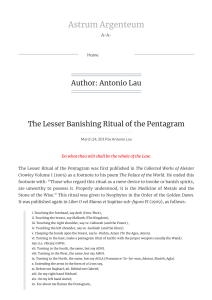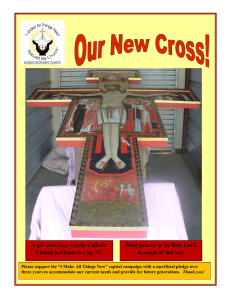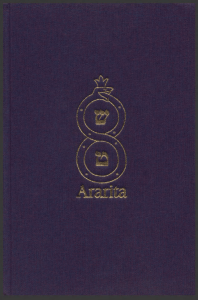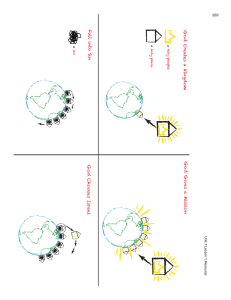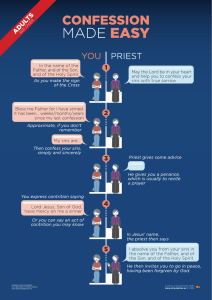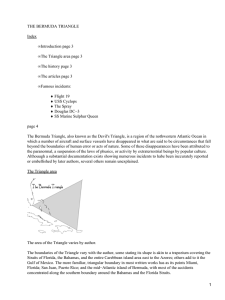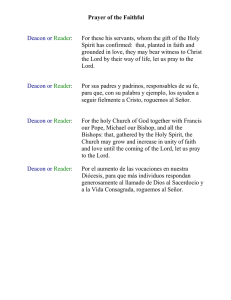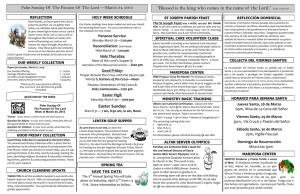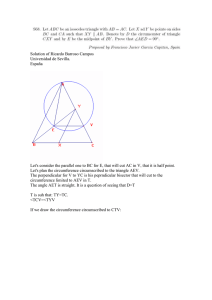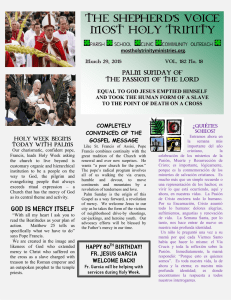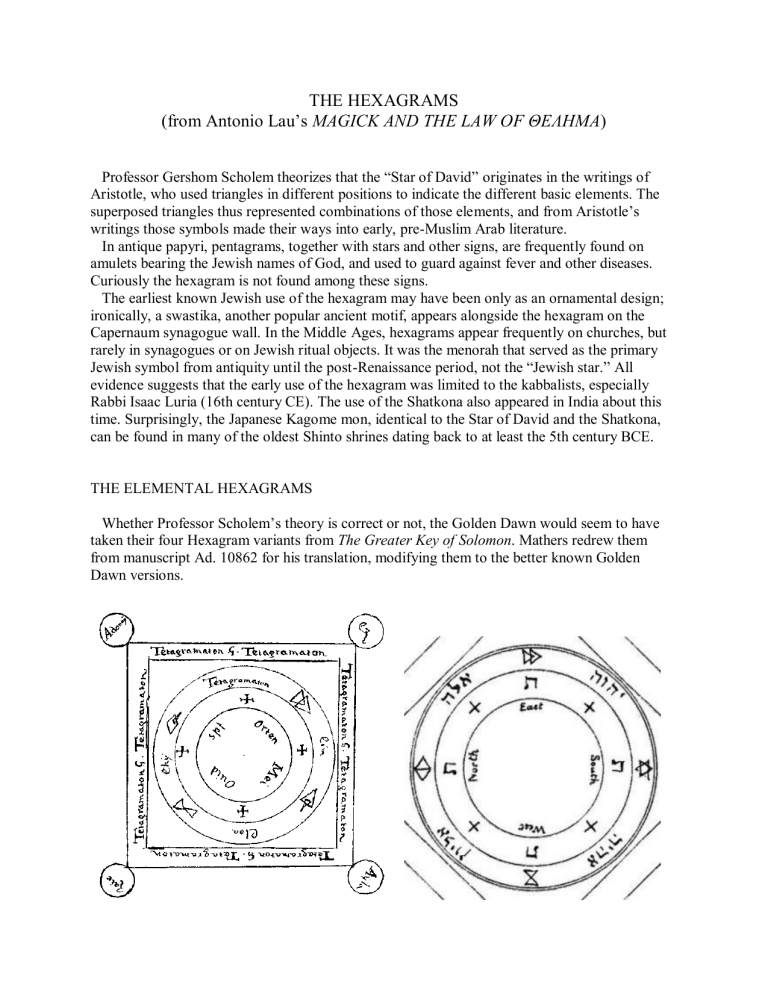
THE HEXAGRAMS (from Antonio Lau’s MAGICK AND THE LAW OF ΘEΛHΜΑ) Professor Gershom Scholem theorizes that the “Star of David” originates in the writings of Aristotle, who used triangles in different positions to indicate the different basic elements. The superposed triangles thus represented combinations of those elements, and from Aristotle’s writings those symbols made their ways into early, pre-Muslim Arab literature. In antique papyri, pentagrams, together with stars and other signs, are frequently found on amulets bearing the Jewish names of God, and used to guard against fever and other diseases. Curiously the hexagram is not found among these signs. The earliest known Jewish use of the hexagram may have been only as an ornamental design; ironically, a swastika, another popular ancient motif, appears alongside the hexagram on the Capernaum synagogue wall. In the Middle Ages, hexagrams appear frequently on churches, but rarely in synagogues or on Jewish ritual objects. It was the menorah that served as the primary Jewish symbol from antiquity until the post-Renaissance period, not the “Jewish star.” All evidence suggests that the early use of the hexagram was limited to the kabbalists, especially Rabbi Isaac Luria (16th century CE). The use of the Shatkona also appeared in India about this time. Surprisingly, the Japanese Kagome mon, identical to the Star of David and the Shatkona, can be found in many of the oldest Shinto shrines dating back to at least the 5th century BCE. THE ELEMENTAL HEXAGRAMS Whether Professor Scholem’s theory is correct or not, the Golden Dawn would seem to have taken their four Hexagram variants from The Greater Key of Solomon. Mathers redrew them from manuscript Ad. 10862 for his translation, modifying them to the better known Golden Dawn versions. However, these forms can also be detected in a few illustrations found in Secret Symbols of the Rosicrucians, compiled between 1785 and 1788 by an unknown Rosicrucian, then translated and published by Franz Hartmann in 1888. These forms are used in the Lesser Ritual of the Hexagram given in Liber O. But in contrast to the Magical Circle in The Greater Key of Solomon Circle, the Air Hexagram is used in West and the Water Hexagram in the North, following the order of the Kerubim on the Circular Altar over the tomb in the Vault of the Adepts. THE HEXAGRAM OF THE PLANETS The Earth Hexagram is essentially the same as the Hexagram of Saturn used in the Greater Ritual of the Hexagram. The full instructions are in Liber O, beginning with: “The Hexagram of Earth alone is used. Draw the hexagram, beginning from the point which is attributed to the planet you are dealing with.” That is, this same form is also used for the other Planets and fits upon the Tree of Life centered around Tiphareth; this familiar arrangement determines where the starting point of the Hexagram depending on which planet is needed. Crowley calls this the Hexagram of the Planets in Liber 777 Revised: “Note that Saturn is attributed to Daath in the hexagram of the planets. This is the creative Saturn, the hidden God, and the Daath of the apex of the upper triangle of the hexagram is in reality a concentration of the Trinity of the Supernals. The hexagram must not be like ‘the Stooping Dragon,’ crowned with a falsity.” This is repeated in The Book of Thoth in the text explaining his Hexagram diagram: “This diagram illustrates the Solar system on the Tree of Life. Saturn is in the position of the nonexistent Sephira, Da’ath, but it resumes the characteristics of the three Sephiroth above the Abyss. The doctrinal point is that as this does not exist on the Tree in nature, it is the problem of the seeker after truth to penetrate the obscurity of Saturn, and to discover therein the Supernal Triad in a form linked to his own mind by its position in the Solar system.” In Liber 777, the mysterious Heavenly Hexagram also appears in Column CXXIV. There is no explanation of the Heavenly Hexagram given anywhere in Crowley’s writings, only a vague allusion to it in Liber 418: “And this is that mystery which is spoken of in the Acts of the Apostles; that Jupiter and Mercury (Kether and Chokmah) visited (that is, inspired) Ephesus, the City of Diana, Binah — was not Diana a black stone? — and they burnt their books of magick.” The best theory I’ve managed to come up with is that the planets were intended to match the numbers of the Hebrew letters: Beth = 2 = Mercury, Gimel = 3 = Moon, Daleth = 4 = Venus. Aleph is Air, and Jupiter is the Lord of Air; Heh was originally attributed to Aries, ruled by Mars; Vau = 6 = the Son of Tetragrammaton also attributed to Tiphareth. All the same, in practice there are only the most tenuous of speculations as to what the Heavenly Hexagram represents. These will be discussed in connection to the Holy Hexagram and Liber XXXVI. The Hexagram of the Planets (centered around Tiphareth) is undoubtedly the same figure Crowley calls the Hexagram of Nature in Liber 333. “In the ordinary Hexagram, the Hexagram of nature, the red triangle is upwards, like fire, and the blue triangle downwards, like water.” However, the attributions of the planets to these Elemental triangles gives us pause. It’s true that Chesed (Jupiter), Geburah (Mars), and Yesod (Moon) are connected to Water, especially through the Zodiac signs they rule. But with the exception of the lower Fire attribute of Netzach (Venus), there is no particular connection of Fire to Hod (Mercury) and Binah (Saturn), or even to Daath for that matter. If the descending triangle gives us the Water signs of Scorpio, Pisces, and Cancer, then the ascending triangle gives us the Earth signs instead of the Fire signs. Yet the Hexagram of AHIHVH seems to confirm it, in part at least. The old Golden Dawn spelling of IAO is Yod, Aleph, and Vau. Yod is here in the place of Hod; Yod is Virgo, ruled by Mercury; Mercury is attributed to Hod. Vau is here in the place of Netzach; Vau is Taurus, ruled by Venus; Venus is attributed to Netzach. HHH in AHIHVH is said to conceal the Mother Letters; Mother in IHVH, the first H, is Water. H is on every point of the descending triangle. The only anomaly here at all is the Aleph at the top. But Liber 777 Revised tells us: “...Capricorn, the sign which represents the zenith in the Zodiac” and “Capricorn is the zenith of the Zodiac as Kether is of the Sephiroth.” And as Kether is zenith of the Sephiroth, so could Aleph be the zenith of the Letters; at least they both have the same numerical value. While this arrangement contradicts the arrangement given to it in The Golden Dawn, which uses the Air and Fire signs on the points of the two triangles, we must keep in mind that Leo is NOT ruled by the Moon, even if Teth and Yesod have the same number (9). But Cancer IS ruled by the Moon, and after all, this is now the Aeon of Horus. According to the Cry of the 8th Aethyr in Liber 418, “secretly the blue triangle that descendeth is Nuit, and the red triangle that ascendeth is Hadit” and [in the footnotes] “Ayin or Capricorn is Set or Hadit, the Eye: and He is that Hadit who is manifested as 418.” It occurred to me that the ascending triangle of the Hexagram of the Planets could possibly symbolize the Mountain of Abiegnus, the base of which would be Peh, the foot of the mountain being the intersection of Peh and Samekh. Liber Cheth vel Vallum Abiegni translates to “The Book of the Wall of Abiegnus,” and it is the Holy Book that deals with the Crossing of the Abyss. On the Sun card, the Wall surrounding the peak of the Mountain is the Abyss, the peak itself poking out just enough to reach the Trinity of the Supernals. With regard to the wall, it should be noted that it completely encircles the top of the mound; this is to emphasize that the formula of the Rose and Cross is still valid in terrestrial matters. But there is now, as was not previously the case, a close and definite alliance with the celestial. It is also most important to observe that the formula of the Rose and Cross (indicated by the wall-girt mound) has completed the fire-change into “something rich and strange”; for the mound is green, where one would expect it to be red, and the wall red, where one would expect it to be green or blue. The indication of this symbolism is that it must be one of the great advances in adjustment of the new Aeon to work out simply and without prejudice the formidable problems which have been raised by the growth of civilization. [The Book of Thoth] THE HOLY HEXAGRAM In Liber XXXVI, the Adept is instructed to make the Holy Hexagram in all four quarters of the Circle. Although none of his published writings indicate exactly how to make the Holy Hexagram, Crowley mentions it by name in several places, giving us a few hints. The most obvious of these hints is Liber 333, chapter 69, and its commentary: This is the Holy Hexagram. Plunge from the height, O God, and interlock with Man! Plunge from the height, O Man, and interlock with Beast! The Red Triangle is the descending tongue of grace; the Blue Triangle is the ascending tongue of prayer. This Interchange, the Double Gift of Tongues, the Word of Double Power — ABRAHADABRA! — is the sign of the GREAT WORK, for the GREAT WORK is accomplished in Silence. And behold is not that Word equal to Cheth, that is Cancer whose Sigil is [69]? This Work also eats up itself, accomplishes its own end, nourishes the worker, leaves no seed, is perfect in itself. Little children, love one another! (COMMENTARY) The key to the understanding of this chapter is given in the number and the title, the former being intelligible to all nations who employ Arabic figures, the latter only to experts in deciphering English puns. The chapter alludes to Levi’s drawing of the Hexagram, and is a criticism of, or improvement upon, it. In the ordinary Hexagram, the Hexagram of nature, the red triangle is upwards, like fire, and the blue triangle downwards, like water. In the magical hexagram this is reversed; the descending red triangle is that of Horus, a sign specially revealed by him personally, at the Equinox of the Gods. (It is the flame descending upon the altar, and licking up the burnt offering.) The blue triangle represents the aspiration, since blue is the colour of devotion, and the triangle, kinetically considered, is the symbol of directed force. In the first three paragraphs this formation of the hexagram is explained; it is a symbol of the mutual separation of the Holy Guardian Angel and his client. In the interlocking is indicated the completion of the work. Paragraph 4 explains in slightly different language what we have said above, and the scriptural image of tongues is introduced. In paragraph 5 the symbolism of tongues is further developed. Abrahadabra is our primal example of an interlocked word. We assume that the reader has thoroughly studied that word in Liber D., etc. The sigil of Cancer links up this symbolism with the number of the chapter. The remaining paragraphs continue the Gallic symbolism. The Holy Hexagram is also mentioned briefly in Liber 333 chapter 26: “...the carapace of the Tortoise supports and covers all. This Tortoise is sixfold, the Holy Hexagram.” Although the note attached to this makes a definite connection to a hexagram by stating “In nature the Tortoise has 6 members at angles of 60 degrees,” Liber 777 Revised attributes the Tortoise to Yesod. In the explanation of column XXXVIII, line 9 [Yesod] we read: “Tortoise, as supporting the Elephant, hence equivalent to Atlas. (Compare the Book of Lies, Cap.XXVI.)” Note the specific reference to Liber 333, chapter 26. The Tortoise is attributed to Yesod, the Sephira that corresponds to the Moon. Abrahadabra is specifically tied in with Cheth, whose Yetziratic attribution is Cancer, the sign ruled by the Moon, the planet corresponding to Yesod. According to Liber O: “For the Zodiac use the Hexagram of the planet which rules the sign you require...” Since the Moon is the ruling planet of Cancer, it would make perfect sense that the Lunar Hexagram would be used for the Holy Hexagram: Abrahadabra, Cheth, Cancer, Moon, Yesod. Describing the 10 of Disks in The Book of Thoth, Crowley again mentions the Holy Hexagram: Among the Geomantic figures, Mercury in Virgo is Conjunctio. The meaning, conjunction, is shown plainly by the attraction of the descending (female) Triangle, the cipher of the Yoni, to the ascending (male) Triangle, that of the Lingam. This union completed, they appear interlaced, forming the figure of Capricornus, the Sign in which the Sun finds his rebirth. It is the Holy Hexagram, the symbol of the uniting of the Macrocosm and the Microcosm, the accomplishment of the Great Work, the Summum Bonum, True Wisdom and Perfect Happiness. In the Commentary on the Book of the Law, we read: It is also to be considered that Nu is connected with North, while Had is Sad, Set, Satan, sat (equals “Being” in Sanskrit), South. He is then the Sun, one point concentring Space, as also is any other star. The word ABRAHADABRA is from Abrasax, Father Sun, which adds to 365. For the North-South antithesis see Fabre d’Olivet’s Hermeneutic Interpretation of the Origin of the Social State in Man. Note sax also as a Rock, or Stone, whence the symbol of the Cubical Stone, the Mountain Abiegnus, and so forth. It is significant that Crowley references this book by Antoine Fabre d’Olivet, as it contains a certain diagram of particular interest to us concerning the Hexagrams. On this diagram, there are three smaller circles inside on large circle. Placing the Tree of Life on these three inner circles shows that the “ordinary Hexagram of nature” can clearly be found in the middle circle where any student of Magick and the Holy Qabalah would expect to find it. The larger Hexagram could be taken as the Holy Hexagram expanding from the ordinary Hexagram rather than being just a mere inversion. While there are probably a number of ways to interpret the plunging of God and Man to interlock with each other and Beast, it seems to me that the three inner circles represent God, Man, and Beast. The circles of God and Man are interlocked by the Second Triad, while Man and Beast are interlocked by the Third Triad. The “plunging down” occurs by the medium of the paths Gimel (God), Samekh (Man), and Tau (Beast), without ever loosing the connection to Kether. The plunging would extend the descending red triangle of Horus down to Malkuth, as it is written in Liber LXV, “now is Hoor let down into the Animal Soul of Things like a fiery star that falleth upon the darkness of the earth.” Nephesh is the Animal Soul of Things and Nephesh is attributed to Malkuth. Thus, this Holy Hexagram theory would give a new dimension to “in the Column stands the six-rayed Star.” Below, a later illustration of Stanislas de Guaita reduces the above design to its circle components. If the idea is not immediately obvious, the lineal figures of Fabre D’Olivet’s diagram were given in color to show how the Holy Hexagram expands from the ordinary Hexagram, and below that another diagram to show the Sephiroth marked on the three inner circles. One cannot help but notice that all four of the Elemental Hexagrams can be found on this diagram. “Plunge from the height, O God, and interlock with Man! Plunge from the height, O Man, and interlock with Beast!” Again: God, Man and Beast would hint at a threefold development of the Holy Hexagram. These three levels are represented by the circles placed on the Tree of Life. The top circle would include Sephiroth 1, 2, 3, 4, 5, and 6. The middle circle would include 4, 5, 7, 8, and 9. The bottom circle would include 6, 7, 8, and 10. The Triads are on Diagram 48 from The Temple of Solomon the King. As mentioned before, “...the carapace of the Tortoise supports and covers all. This Tortoise is sixfold, the Holy Hexagram.” The carapace of a tortoise has thirteen large scutes, arranged in a symmetrical pattern that could incorporate the Tree of Life, including three “interlocked” circles connecting the ten Sephiroth, as demonstrated in the image above. And as there are thirteen scutes of the tortoise’s carapace, the verses in each chapter of Liber DCCCXIII vel ARARITA are numbered 0-13 (1-10 correspond to the Sephiroth). AChD (Achad, “unity”) equals 13, as ARARITA is notariqon for the Hebrew phrase “Achad Rosh Achdotho Rosh Ichudo Temurato Achad” which has been translated as “One is His Beginning; One is His Individuality; His Permutation is One.” Liber DCCCXIII is “An account of the Hexagram and the method of reducing it to the Unity, and Beyond.” The Triads are also mentioned in Liber 333 Chapter 0, which “follows the Sephirotic system of the Qabalah, and constitutes a sort of quintessential comment upon that system. Those familiar with that system will recognise Kether, Chokmah, Binah, in the First Triad; Daath, in the Abyss; Chesed, Geburah, Tiphareth, in the Second Triad...” These First and Second Triads are referred to as GOD; these two Triads also represent the six Sephiroth from Kether to Tiphareth, as does the top circle of my hypothesis. Between these two Triads there are five sentences attributed to The Abyss. Throughout Liber 333, other commentaries repeatedly attribute Macroprosopus and the Macrocosm to Kether, while Microprosopus and the Microcosm is concentrated in Tiphareth. This would seem to indicate that the Great Symbol of Solomon was a Hexagram formed of the first six Sephiroth of the Tree of Life, from Kether to Tiphareth. The Macroprosopus would be represented by the Supernal Triad; the Microprosopus would be reflected in Chesed, Geburah, and Tiphareth. This horizontal line that divides the Hexagram of The Great Symbol of Solomon in half would correspond to the Abyss, which separates the Actual from the Ideal. But why five sentences in Liber 333 Chapter 0 for the Abyss when each of the first six Sephiroth have only one line each? Another clue in the comment to chapter 69 is: “Abrahadabra is our primal example of an interlocked word. We assume that the reader has thoroughly studied that word in Liber D.” In Liber D (and Liber LVIII as well) we are given three “methods” of qabalistic application involving Abrahadabra under the number 418 involving a Hexagram and a Pentagram. First Method: Second Method: The first method shows a Pentagram in between two sets of three letters that closely resembles the way the First Triad and Second Triad would look upon the Tree of Life. Perhaps this Pentagram is even connected to the five sentences of Liber 333 chapter 0 regarding the Abyss. The second and third methods have the Pentagram and Hexagram side by side; but in the second method, the letters of the top three points spell the word BHR and the bottom three points spell DBR, each letter placed in the numerical order as would be the Sephiroth upon the Heavenly Hexagram. The third method attributes the top three points to Amoun, Thoth and Mout (the Vulture Goddess of Motherhood), as the Heavenly Hexagram gives us Jupiter, Mercury, and Luna. The bottom three are Isis, Horus and Osiris: Venus, Mars and Sol on the Heavenly Hexagram. Amoun/Jupiter, Thoth/Mercury, Mout/Moon; Isis/Venus, Horus/Mars, Osiris/Sun. Still, it seems hard to imagine that the Holy Hexagram is simply the exact same as the Heavenly Hexagram especially with all the other evidence involved. Another reconciliatory theory is that the Sephiroth of the Heavenly Hexagram “plunge from the heights” — while expanding — until completely subsuming the entire Tree of Life along with the ordinary Hexagram. Once the bottom point (the Tiphareth of Horus’ descending red triangle) reaches Malkuth (“the Animal Soul of Things”), it becomes the Holy Hexagram that has rearranged the planetary attributions to conform to the Ten Sephiroth in the Seven Palaces. This would still differ from the ordinary Hexagram: even though Saturn is in the position of the non-existent Sephira Daath, but resumes the characteristics of the three Sephiroth above the Abyss, The Book of Thoth states that “The tenth Sephira, which refers to Earth, is not shown on this figure. For this number represents the Nephesh, the animal soul of man, the crystallization of the mind, and the Daughter or He final of Tetragrammaton.” Placing the Holy Hexagram on the Seven Palaces diagram WOULD include Malkuth, the Daughter, Earth, and the Nephesh. Note that the Beast 666 of Revelation is said to have ten horns on seven heads. Here we would have Man interlocking with Beast, especially as the number of the Magick Square of Tiphareth (6) is 666. Since Yesod and Malkuth share a circle, this same Hexagram would still apply to the Hexagram of the Astrological sign Cancer. That is, one begins drawing the Holy Hexagram from the bottom point. It should also be noted that a design similar to that of Fabre d’Olivet also appears in Helena Petrovna Blavatsky’s Isis Unveiled, which Crowley also would have surely known about. THE UNICURSAL HEXAGRAM It is often claimed that Crowley got his idea for the Unicursal Hexagram from the Golden Dawn’s third irregular form of the hexangle, but this is very unlikely. In a letter to Charles Stansfeld Jones dated May 8, 1916, he wrote: “I have an idea that every line in a unicursal figure should be equal to every other line, and also that unicursal figures should be capable of dextrorotary description, that is when they are closed figures. You can describe a hexagram unicursally, but the result is altogether evil.” In other words, HE HATED IT. But at some point within the next 13 years, something seems to have changed his mind, when his own version was printed on the cover of Magick. [Above left, the Golden Dawn’s irregular form of the hexangle.] The Unicursal Hexagram, with its flower of five petals in the center, was also a part of his personal lamen, which included the Mark of the Beast, an inverted Pentagram, the Cross of the Hierophant, the seven pointed Star of Babalon (with an unusual eye at the bottom point — “Eye of Hoor unto the zenith”?), and two alternating Taijitu symbols, all in full color. The Unicursal Hexagram itself was painted in golden yellow, and its center was right at the intersection of Gimel and Teth on the red-orange Cross of the Hierophant. This seemed to place the Unicursal Hexagram at a slightly different place on the Tree than the ordinary Hexagram or even the Holy Hexagram (if my theory regarding the latter is actually correct). But it seems to me that there was certainly no intention for it to replace either of those Hexagrams, as it would have conflicted with all that had already been written about the others in the Official Publications. The only place it seems to have been intended to be used was the Ritual of the Mark of the Beast. There is no indication that the Unicursal Hexagram follows the Elemental arrangement of the Golden Dawn irregular form of the hexangle. The upper right point indicates a connection to Chokmah (arcehtypal Fire) as the upper left point indicates Binah (archetypal Water). Even though Hod is the lowest reflected form of Water, it would seem logical to place Air here. Even though Netzach is the lowest reflected form of Fire, it would be logical to place Earth here. As the bottom point is directly in the center of Yesod, it would be logical to place the Moon here, but with the top point in Kether, and the center in Teth, it would be more logical to place Spirit at the top and the Sun (Leo) in the center. Notice that out of Kether springs the three Negative Veils of Existence in the form of the Mark of the Beast, just as Malkuth springs out of Yesod marked with the face of Baphomet: “now is Hoor let down into the Animal Soul of Things like a fiery star that falleth upon the darkness of the earth.” [Liber LXV] “I swoop down upon the black earth; and it gladdens into green at my coming.” [Liber Tzaddi] In a strange way, this Hexagram of the Beast might also be applied to the Ten Sephiroth in the Seven Palaces, but in a different way; more expansive even, but it is clear from the Lamen that the midpoint is still centered on the intersection of Gimel and Teth, and it should be thought of as interchangeable with the Holy Hexagram. Contrary to popular trend, it seems highly unlikely that the Unicursal Hexagram, except as a highly respected symbolic representative of the Beast 666, was intended to be used in any other rituals aside from the Mark of the Beast ritual. While there is no reason it cannot be utilized in a future personalized ritual created by the individual magician, one should think twice before using it as an alternative to the ordinary Hexagram of the Planets or of Nature. It is also interesting to note that the practical drawing of the trigrams of the Unicursal Hexagram would actually resemble lightning bolts. To maintain any sense of balance in using these, it would seem wise to consider that there are only four ways to use it properly: from top to lower right or bottom to upper left for invoking, from top to lower left and bottom to upper left for banishing. And the symbolism for doing so has yet to be worked out, as far as I’m aware of. Using it in the Greater Ritual of the Hexagram, a trend started by Israel Regardie, would only create a strange imbalance that is sure to disturb the intuition, if not the conscious mind altogether. Not to mention, substituting it for the Greater Hexagram of the Sun is just plain lazy. But it’s YOUR karma; Do what thou wilt… Around 1943, Crowley gave us some interesting new uses for the Unicursal Hexagram in Magick Without Tears: The Disk. This ought to be of pure gold, with your own Pantacle, designed by yourself after prolonged study, graved thereupon. While getting ready for this any plain circle of gold will have to serve your turn. Quite flat, of course. If you want a good simple design to go on interim, try the Rosy Cross or the Unicursal Hexagram. The Robe may well be in the form of the Tau Cross; i.e. expanding from axilla to ankle, and from shoulder to — whatever you call the place where your hands come out. You being a Probationer, plain black is correct; and the Unicursal Hexagram might be embroidered, or “applique” (is it? I mean “stuck on”), upon the breast.
